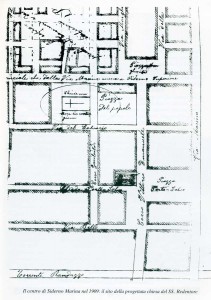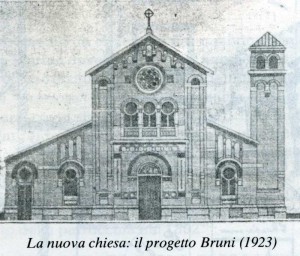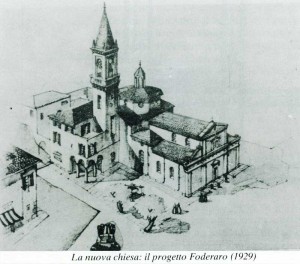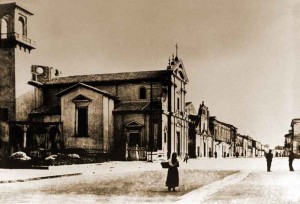STATE OF THE PARISH OF MARINA DI SIDERNO
 Number of cores 2500.
Number of cores 2500.- Title II of the said parish is St. Mary of Portosalvo.
- Fair share of the same in the beginning of its establishment was fixed in this municipality was discussed for ducati 100. Now the City Council Whereas the Municipality of Siderno is poor, so-called fair was established at sixty ducats 60 year.
- The succennata Parish has no other asset of a pension fund or rustic, or urban.
- Maintenance of the Church II, wax, oil, sexton, etc. dependent on charity and alms de’ faithful. No more, nothing less.
That today there 27 July 1862
Joseph Sarroino Treasurer Cure
Report lace, as seen, but subject to a very narrow economic condition. Growing, instead, the quality of the cultural and devotion to the Blessed Virgin, which so recognized, day by day, special care for the people sidernese and wondrous deeds. At his benevolence was attributed, specifically, the protection of the country's cholera epidemic 1866-67, and what you can catch the echo even in the verses of contemporary dialect poet Locrian Cola Naples:
Puru Siderni s'ha portatu goods
In Portusarvu He Meraculusa,
As lu lu nta primu Postu cellular villagers.
Meanwhile, to rule the Church was called, the 14 May 1862, with the title of treasurer, Don Giuseppe Sarroino. The latter was appointed parish priest 19 March 187442 and held the parish until his death, took place on 3-8-1886, a 66 age. The’ 11 December of that year, to succeed, was transferred from the pastor of the Mam-wheel B.M.V. Carmel, Don Nicodemus Ferrari. In 1882 had taken the first steps towards the establishment of a confraternity dedicated to the holder of the parish.
It’ the case, at this point, back on the big issue of the Navy, that of building a new and bigger church.
We have already mentioned the intentions proclaimed on several occasions, both by secular that by ecclesiastical, in previous decades. We also know that he had been chosen a soil “the fund currently [1857] owned by Mr.. D. Giovanbattista Correale” and that a subscription in the open 1857 had yielded commitments to 660 ducati. Concrete, but, had not done anything. The problem was relieved from 1870 and a whole series of resolutions and documents in the archives is to testify as it seems that someone or something always cynically fun to make very difficult the realization of public works in our country. Memory, to name, Board resolutions of the 28-4-1870, of 5-5-1874, of 2-5-1878, of 9-2-1891, dell’11-11-1897, of 22-12-1898: is recognized in all the mandatory nature of the new construction; is for hand-committees; you acquire opinions; choosing soils; it gives, but, also to demagoguery (as when, under the influence of masons seeking work, and the proposal of the director Giuseppe Romano – that to which we must largely attribute the “merit” the demolition of the tower – get distracted funds already set aside for the construction of the church and they are used to complete the church of the Carmine) and discusses – still – whether it is better to enlarge the old church or build a new one. A good time seemed to come at the expiration of the century. The 2 March 1899 the City Council gave the final opinion to build the new church (that would have been entitled to SS. Redeemer, “the new century dedicated to him”) in the Piazza del Popolo (behind the present Town Hall), and the first stone was blessed by Bishop Mangeruva the 5 July 1900, but the construction was interrupted only a few months after the start, never to be taken more; there is news that even in 1903 There was again directed to expand to enlarge the old church. Some events that took place in the early years of this century they may have in some way contributed to further delay the solution of the problem: firstly, the long fight that followed the decision of the City (28-4-1901) not to pay more than the con-grua; then, the translation from the Navy Superior Siderno of the parish of S. Maria dell'Arco (January 1909). For this latter fact, the church of Portosalvo matrix and became its pastor held the title of Dean, but this was not sufficient to really hasten a solution to the problem under discussion, nor, because of the war well known, was more favorable the next epoch.
 In 1919 Archpriest Ferrari resigned for health reasons and was called to succeed Monsignor Vincenzo Raschellà (27-10-1920), which put the issue of the church at the top of its work program and did not hesitate to use tones crusade to solicit the solution. God wills it, is, in fact, entitled to appeal to him widespread in the octave of the feast of 1920, an appeal vigorous and sustained by trust, aims to make resume work stopped in Piazza del Popolo. But on the ground, he was already thinking of building something else. So it was that, on the initiative of former Mayor Peter Campoliti, was dusted off the old man about to build a new church on the same floor of the old (considered to be in poor condition the 18 January 1923 in a report of Civil Engineers). The project, drawn up by the engineer. Peter Brown of The Building of Reggio Calabria, was approved by the Ministry of Public Works. the 16 November 1923. Even with such a project is passed to the execution phase, rather, having again decided – lively debate between –
In 1919 Archpriest Ferrari resigned for health reasons and was called to succeed Monsignor Vincenzo Raschellà (27-10-1920), which put the issue of the church at the top of its work program and did not hesitate to use tones crusade to solicit the solution. God wills it, is, in fact, entitled to appeal to him widespread in the octave of the feast of 1920, an appeal vigorous and sustained by trust, aims to make resume work stopped in Piazza del Popolo. But on the ground, he was already thinking of building something else. So it was that, on the initiative of former Mayor Peter Campoliti, was dusted off the old man about to build a new church on the same floor of the old (considered to be in poor condition the 18 January 1923 in a report of Civil Engineers). The project, drawn up by the engineer. Peter Brown of The Building of Reggio Calabria, was approved by the Ministry of Public Works. the 16 November 1923. Even with such a project is passed to the execution phase, rather, having again decided – lively debate between – for a construction exnovo and larger, we addressed on the current site, but it was necessary to draw up a new project, that was entrusted to engineer. Joseph Foderaro.
for a construction exnovo and larger, we addressed on the current site, but it was necessary to draw up a new project, that was entrusted to engineer. Joseph Foderaro.
Overcome the many obstacles that presented themselves day after day incredibly, finally, the 14 August 1929, Welcome to the firm (then replaced by the company Polverari) opened the site and began building, that, but, proceeded controversy between increasingly hot and with such slowness that the 15 May 1934 Bishop. Raschellà thought to convene a public meeting to take stock of the situation.
In the report herein required, Archpriest defended himself before all the allegations that were addressed to him to be to delay the execution of works for the claim to make changes during construction, in an attempt to expand the initial project with the construction of the apse, the raising of the dome, the opening of a side chapel . . . These responsibilities were accepted by him: he – he said – interfered with good intentions, to give rise to the largest and most majestic temple, but – always he said – the delays were to be charged to the inefficiency of the firm outsources matrix and the project manager, always absent.
Even the stress born by the shareholders, in a situation made more precarious by the political and military obligations, produced the completion of the work. The construction of the church, even at the top of his thoughts, had not been the only goal of the program to the combative priest, nor had absorbed all the energy. Monsignor Raschellà stroked the secret thought of getting to the title of his church sanctuary: hence the care and attention to creating favorable conditions for the fulfillment of this aspiration. It’ this aspect that must be “read” the solemn manifestation of Pontifical coronation of the image of Mary SS. of Portosalvo, celebrated, September 8 1923, in a crowd cheering and uncontrollable, with the intervention of Bishop. G.B. Chiappe, diocesan bishop, assisted by the brothers of Bova, Bishop. A. Taccone, and Squillace, Bishop. A. Melomo, and Bishop. G. Mittiga, Abbot of Wrists. On the same occasion was celebrated a significant Eucharistic Congress – Mariano and was founded parish bulletin, only, in our diocese, to live a life of uninterrupted more than sixty years. So it was that, at different times, were offered or acquired:
- of gilt bronze candlesticks (gift of Joseph Balzamo);
- a Roman cross (gift of Gaudenzio Giacon);
- a monstrance “Byzantine style” (gift of Josephine Bello);
- a silver pyx (gift of Gina Macedonio);
- the pictures of the Via Crucis (Artistic reproduction of Via Crucis home Alinari in Florence, of Tiepolo; Albanian gift of Nicola);
- the central altar (gift of the family Campoliti Corigliano);
- the balustrade of the central nave (gift of Vincenzo Macedonio);
- the marble pulpit (gift of Charles Caricari and faithful who have emigrated to the United States) ;
- the baptismal font (gift of Joseph Errigo) ;
- the fonts (gift of the spouses Letizia) ;
- the crosses of consecration (gift Giovannina and Domenico Correale Santacroce) ;
- four new bells;
- a framework of S. Joseph (copy of G. Kidneys, performed in Turin by E. Mastromatteo; gift of Joseph Abbruzzini);
- the main door and a side (gift of Teresa Roccisano).
 It was a kit – as you can guess, and largely still be seen – very decent, chosen with taste and – above all – offered with great devotion. Unfortunately, the building was intended to welcome that was slow to be completed, without understandable reasons. Least of all agreed to include the Dean Raschellà, which, established the futility of verbal protests, finally decise, see action. So it was that, “procured” municipal ordinance (15 July 1944 Sindaco A. De Leo) which declared unfit and dangerous for old church, the 20 July 1944 he “occupied” not yet completed the building of the new church, trasferendovisi with stoles and candles immediately and building into divine worship.
It was a kit – as you can guess, and largely still be seen – very decent, chosen with taste and – above all – offered with great devotion. Unfortunately, the building was intended to welcome that was slow to be completed, without understandable reasons. Least of all agreed to include the Dean Raschellà, which, established the futility of verbal protests, finally decise, see action. So it was that, “procured” municipal ordinance (15 July 1944 Sindaco A. De Leo) which declared unfit and dangerous for old church, the 20 July 1944 he “occupied” not yet completed the building of the new church, trasferendovisi with stoles and candles immediately and building into divine worship.
It was a bold initiative, probably the only useful to permanently unlock the situation. It’ true that some parts of the church, sketchy – such as the bell tower and dome – and then covered provisionally, will never be completed, but it is also true that in this way the church could finally begin to be visited and, over time, be brought to the current conditions, pretty decent.
And the old church? That, after serving for at least three centuries, the events of the life of our Navy, he agreed to make, with great humility and modesty, still a service to Sidernesi, becoming “digging” of all the material used for the new church. Reduced, finally, a mere skeleton, it was ordered final demolition, pitifully com-pleted at the end of the 1945 and the first days of 1946. Where were his walls, was designed a square, the center of which, in 1959, was raised, in memory, a white marble column with a statue of the Madonna and the following inscription:
The SIDERNESI RECALL
THIS SACRED PLACE
Where the first
PARISH CHURCH
© Edited by Prof. Enzo D'Agostino